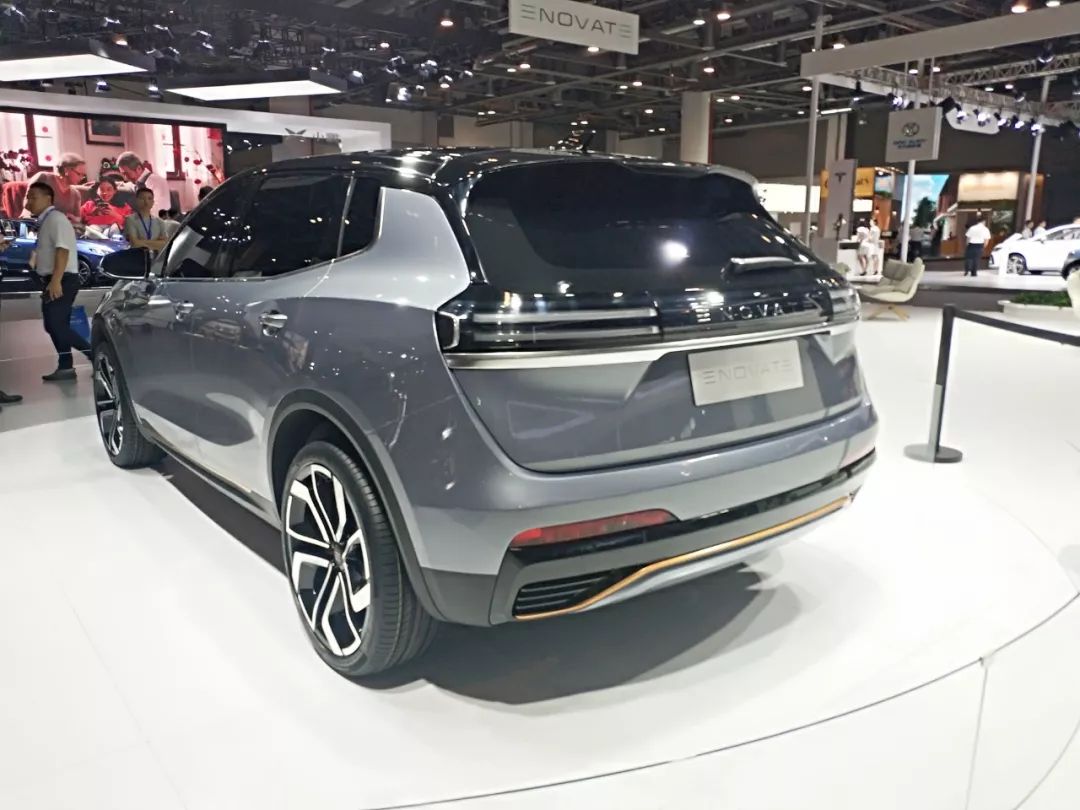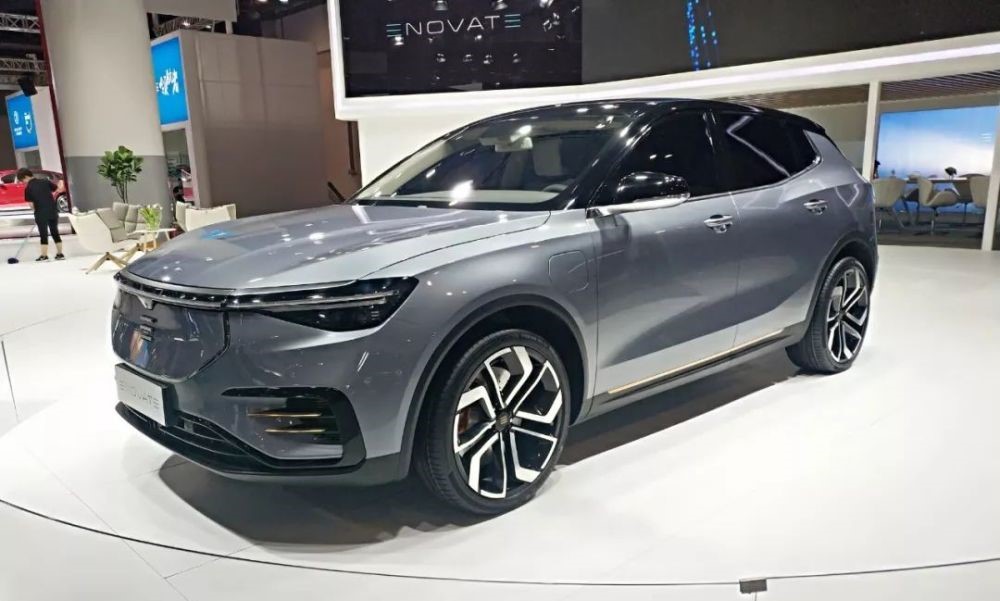NIO has gone public, while WM Motor is about to deliver its first production car, but it’s too early to say who will come out on top in the new automobile camp. There are still several companies in this camp that have not taken the high-profile branding and promotion route at the start-up stage, and their first mass-produced cars are mostly scheduled to be delivered by the end of next year. Yet you can’t ignore them when looking at three dimensions: team, technology, and capital.
Take DearCC, for instance.
Saying that DearCC’s first mass-produced car will be delivered next year is not entirely accurate because DearCC’s first model, the EV10, was launched as early as November 16th last year. Since then, DearCC has launched a mid-to-high end brand, ENOVATE, and at yesterday’s press conference, ENOVATE’s first quasi-mass-produced SUV made its debut under the ENOVATE brand. This SUV, which is designed, developed, and manufactured solely by DearCC, is planned to be delivered by the end of 2019.


Compared with the lower-positioned EV10 and its relationship with Southeast Motor’s manufacturing, I prefer to use this ENOVATE SUV above as a real yardstick to measure DearCC’s product strength.
But there is a very serious problem: the threshold for car making is very high, and it is a typical capital-intensive industry. After going public, Tesla has continued to raise over 10 billion dollars without turning a profit. What is the logic behind DearCC’s simultaneous operation of two new brands?
We had this idea from the beginning of our establishment: to meet the mainstream market demand of the pure electric car market as much as possible. From our perspective, this market is macroscopically divided into two categories:
One is to solve the basic needs of mobility, to be used as the main means of transportation. It is combined with car-sharing and car rental, which will become a very large market based on the development of automatic driving, car-sharing (sharing economy), and so on.
The other category of people does not regard cars as transportation tools but as an extension of life. They do not see mobility as a simple issue of getting from point A to point B, but possibly to work or enjoy life. Thus, we need to transform it into a mobile platform, starting from the mid-to-high end market.>We have conceived a strategy from the beginning to cover different target markets with one high-end and one low-end brand, in order to satisfy different demands of different consumers. Therefore, for us, developing two brands to satisfy different market needs is a market strategy that was completely clear from the early days. From the perspective of the capabilities of the cars themselves, we started with the EV10 and created a good platform from R&D, manufacturing, sales to the overall market environment. Most of our team members come from major car companies with more than 20 years of experience, but since it is a new team, a composite team, it requires some time to get adjusted.
Developing and manufacturing a product and then controlling it before selling it is also a good process for the entire team to get adjusted. By doing so, when we take the second step, launching the high-end brand according to the same rhythm, the entire team can handle it very well. Launching a high-end brand requires laying a good foundation. From the logical point of view, we must first focus on demand, that is, where is the demand of the consumers? If consumers have demands, we will create products that meet their needs most accurately based on our own capabilities.
(Zhang Hailiang, Founder and CEO of Enovate)
Here, there is a new question that we can explore: Should luxury car brands participate in car sharing?
The world’s top two luxury car brands, Mercedes-Benz and BMW, have both been involved in early-stage car sharing businesses. Mercedes-Benz established Car2Go, while BMW launched ReachNow. The main models for these two car-sharing platforms are the Smart/C-Class and the MINI/3-Series, respectively. Why did both companies choose entry-level models as their main car-sharing vehicles?
Because fundamentally, car-sharing models belong to transportation tools, and shared transportation should prioritize efficiency and TCO (Total Cost of Ownership) benefits. Luxury brands have no advantage in operational cost control in car sharing, and participation in car sharing can also damage the brand image – C-end users do not like to see their car models being used for sharing.
The underlying logic here is that car-sharing models have a clear transportation tool attribute, while luxury car models are more about emotional space attributes.
Regarding Enovate, the double-brand driven logic was unveiled, but why now? According to Enovate, the launch of the first mass-produced car under the ENOVATE brand will be in the second half of next year. This implies that among the smart electric vehicles that are similar to ENOVATE are Mercedes EQC, Audi e-tron, Jaguar I-PACE, and NIO ES6, among many other models. Does this mean that ENOVATE has missed the best window of opportunity and will face intense competition as soon as it is born?Our logic for analyzing market development is as follows: the acceptance of a new thing like pure electric vehicles should start with a shared economy small car and solving point-to-point travel needs as the target. Therefore, the market starts with low-end and mid-range demands. However, with the development of battery technology, connected cars, autonomous driving technology, and driving range, the improvement of user experience, and the increasing number of high-end customers paying attention to the experience and feeling of smart electric vehicles, the demand for electric vehicles in high-end cars is gradually increasing.
Tesla has been trying to tap into this market very early on, and the market is gradually being developed. As many companies have also launched corresponding models, we believe that the release of ENOVATE is the node to be reached.
We think that the mid-to-high-end electric vehicle market may explode in the next two to three years, but it is not an overnight event. Therefore, this market still needs time to be developed. So I think that by next year, it is actually the right time to launch when this market is truly emerging.
It is not good to be too early or too late. We pay a lot of attention to sales of segmented markets. Now, the proportion of pure electric vehicles in segmented markets is very different from that of traditional cars, including the size and positioning of the models. It is in the stage of cultivation and growth, completely different from traditional cars, and it will still take some time to return to the situation where traditional cars are acceptable to most people. So we won’t be late.
As for the issue of competing products, we don’t pay much attention to who we are directly competing with. We are more concerned about consumer needs. For example, we position ourselves at this price point, and at this price point, we will deeply understand what customers need, what kind of configuration they need, what kind of features they need, and what kind of styling they need. Based on this concept, we define our own car model.
We didn’t directly target any competitors, because I think this would lead to homogenization. If you focus too much on how others do it, you may become obsessed with whether I have this feature or not, or how long my wheelbase is compared to theirs. In fact, we do the least benchmarking within the company. We have a philosophy that we hope to compete with all cars in the same category. Therefore, we focus more on the relationship between ourselves and consumers, and do not think too much about price or how competitors do it.
(EHANG founder and CEO, Zhang Hailiang)
From the two key issues mentioned above, we can roughly see EHANG’s thinking on enterprise development and industry development. Of course, there are still some unanswered questions, such as why EHANG is worth looking forward to.
The beginning talked about team, technology, and capital:Team: CEO Zhang Hailiang, CMO Xiang Dongping, CTO Niu Shengfu, CHO Jin Di, CFO Chen Xiaobin, CPO Liu Yan, Styling VP Hakan Saracoglu, and PR VP Zhao Huan all have rich industry experience in the automotive industry. The current size of the DearCC team is close to 1,000 people and continues to expand.
Technology: The intelligent digital architecture IMA, led by the team, will generate eight models in the next 5 years. The IMA architecture can support the development of various types of A-C level vehicles, including SUVs, sedans, MPVs and other different types. The integration of hardware, software, applications and cloud services realizes platform technology sharing.
DearCC Automobile has invested in a passenger car production base covering about 1,000 mu in Shaoxing, Zhejiang, with a total investment of RMB 5.5 billion. The first phase of the project is expected to be completed and put into use in 2019.
Capital: As of now, DearCC has completed RMB 2.5 billion in Pre-A round financing, and A round financing is underway.
Of course, DearCC has some very serious challenges that need to be addressed. For example, the imbalance in the ratio of high-level executives who come from an internet background and those who come from a traditional engineering manufacturing background. Smart electric cars are essentially the integration of traditional automotive and internet industry.
In addition, the threshold for capital in the automotive industry is extremely high. Currently, DearCC’s capital reserves are not particularly outstanding. Considering the dual-brand operation model, the challenges for DearCC are even greater.
Third, the window of opportunity is passing, and the transformation of traditional automotive giants has already begun. Once the big factories begin to exert force, the competitive environment for young vehicle manufacturing companies will become unprecedentedly intense.
However, vehicle manufacturing itself is a challenging and multifaceted art. The DearCC team’s efforts to supplement its shortcomings while moving forward will be worth looking forward to more than a smooth journey.

This article is a translation by ChatGPT of a Chinese report from 42HOW. If you have any questions about it, please email bd@42how.com.
